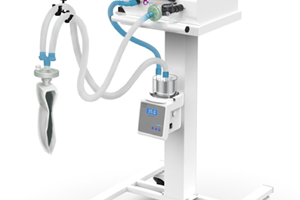The Global Mechanical Ventilator Market size is expected to reach $11.7 billion by 2027, rising at a market growth of 12.7% CAGR during the forecast period.
Mechanical ventilator is the device used to support breathing of patients who is critically ill and unable to breathe by self. A hollow tube, which acts as artificial airway, is inserted into the patient's mouth and down into their trachea to connect patient to the ventilator. In addition, mechanical ventilators are used to assess static compliance of airway resistance and respiratory system abnormalities as a diagnostic tool. The mechanical ventilators market is a life-saving device in medical emergency and surgeries. These devices are majorly used for patients with spinal cord injury, stroke, respiratory disorders, or other disorders.
The growth of the global mechanical ventilator market is majorly driven by increase in prevalence of chronic respiratory diseases such as lung cancer, chronic obstructive pulmonary disease (COPD), asthma, bronchitis, and other lung disorders as well as rise in number of hospitals & diagnostic centers. As per the Globocan 2020, lung cancer is a second ranked cancer in terms of patient count in Europe with estimated 477,534 newly diagnosed patients.
In addition, increase in aged individuals who are susceptible to respiratory disorders is one of the key drivers of the market. For instance, according to the American Cancer Society's 2021 Statistics, most of the people over the age of 65 are prone to lung cancer.
Moreover, advancements in mechanical ventilator Market anticipated to contribute toward the growth of the market. For instance, Philips, a global leader in health technology, offers Respironics V680, a critical care ventilator which uses their proprietary auto-track technology to automatically adapt to your patient's breathing pattern and deliver a high level of synchrony during noninvasive therapy.
COVID-19 Impact Analysis
Furthermore, COVID-19 pandemic has boosted the growth of market. The COVID-19 infection is associated with respiratory failure and requires critical care with ventilator support. Mechanical ventilation has regularly been employed to oxygenate seriously ill COVID-19 patients. In addition, new delta, and omicron variants of COVID-19 with high spreading rate found in mid-November 2021 have increased the risk of third wave across the world. Moreover, key manufacturing companies in mechanical ventilators market and government have taken initiatives to boost the production of market to fulfil the high requirement of ventilators during the pandemic.
Thus, presence of various manufacturers and initiatives taken by government to increase the production of market propelled the growth of the market. However, high cost associated with mechanical ventilators and risk of ventilator associated diseases such as nosocomial pneumonias restrict the market growth during the forecast period.
Market Growth Factors:
Increasing number of ICU Admissions is augmenting he demand for critical care
The burden of respiratory diseases is rising globally, owing to numerous factors such as smoking, obesity, and lifestyle changes. According to the Regents of the University of California, in the United States, approximately 4 million ICU admissions are registered each year. In Germany, around 2.1 million patients are admitted in ICU each year, out of which an estimated 42.0% patients require mechanical ventilation. The increasing demand for critical care equipment, due to increasing number of ICU admissions in emerging and developed countries are some of the major factors anticipated to drive the growth of the market. Additionally, the impact of COVID-19, the number of ICU admissions had an additional impact and the need of critical care equipment.
Soaring Innovations in Intensive Care Unit (ICU) Ventilation
Potential optimization of ventilation bundles begins by re-investigating the critical constituents of respiratory mechanics. Automation of ventilation settings could result in a solution. Closed-loop systems have been categorized into clear, physiological signal-based, and explicit computerized protocols or ECP. ECP systems utilize numerous inputs to curb one or numerous ventilator outputs.
Certain examples of automation of mechanical ventilation include Adaptive Support Ventilation (ASV; which titrates ventilator output on a breath-to-breath basis offering a preset level of minute ventilation while reducing work of breathing), Intelligent ASV (an expansion of ASV, inclusive of an automatized choice of FiO2 and PEEP), and SmartCarePS (regulation of pressure support level based on the patient's respiratory features). Additional examples accessible on the market (although not completely automatized) are proportional assisted ventilation plus (PAV+) and NAVA. The modes of ventilation include non-invasive ventilation and invasive ventilation.
Marketing Restraining Factor:
High Capital Requirement
Purchasing a fleet of ventilators for hospital is a major decision. The cost of acquiring new equipment is part of that decision-making process. There are many ventilator options available to care for a variety of patient needs. Examples include Home care ventilators, Transport ventilators, Low, medium, and high-acuity ventilators, High-frequency ventilators, Noninvasive positive pressure ventilation/continuous positive airway pressure (NPPV/CPAP), bi-level positive airway pressure (BIPAP) systems.
Different ventilators also have different gas delivery designs, including turbine-based air supply and proportional solenoid (PSOL) valve control, or a combination of the two systems. Costs for these ventilators can range from $5,000 to $50,000. Premium or high-acuity ventilators - most commonly found in hospital ICUs - typically have a PSOL gas delivery design and can currently cost between $25,000 and $50,000.










